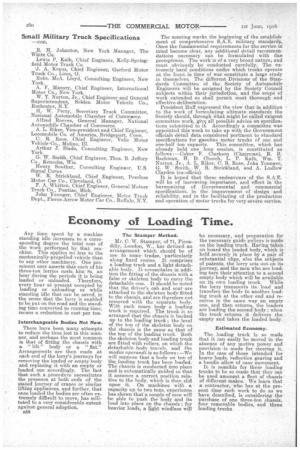Economy of Loading Time.
Page 18

If you've noticed an error in this article please click here to report it so we can fix it.
Any time spent by a machine standing idle increases to a corresponding degree the total cost of the work performed by that machine. This applies no less to the meehanically-propelled vehicle than to any other machinery. One prominent user asserts that each of his three-ton lorries costs him 8s. an hour ,during the periods it is being loaded or unloaded. Therefore, every hour at present occupied by loading or unloading or while standing idle that can be saved, in the sense that the lorry is enabled to be put on the road and the standing time converted to running tune. means a reduction in cost per ton.
Interchangeable Bodies Not New.
There have been many attempts to reduce the time lost in this manner, and perhaps the most common is that of fitting the chassis with a " lift " body or a "flat." Arrangements are then made at each end of the lorry's journeys for removing the loaded or empty body and replacing it with an empty or loaded one accordingly. The fact that such a procedure necessitates the presence at both ends of the stated journey of cranes or similar lifting appliances, and further, that once loaded the bodies are often extremely difficult to move, has militated to a very considerable extent against general adoption.
s58 The Stamper Method.
Mr. C. W. Stamper, of 71, Picea, dilly, London, W., has devised an arrangement which should be of use to some trades, particularly along fixed routes. It comprises a loading truck and a light detachable body. It necessitates in addition the fitting of the chassis with a false or skeleton body to carry the detachable one. It should he noted that the driver's cab and seat are attached to the skeleton body fitted to the chassis, and are therefore not removed with the sepaiate body. With each spare body a loading truck is required. The truck is so arranged that the chassis is backed up to the loading truck ; the level of the top of the skeleton body on the chassis is the same as that of the top of the loading truck. Both the skeleton body and loading truck are fitted with rollers, on which the detachable-body travels, and the modes operandi is as follows :—We will supnose that a body on ton of the loading truck has been loaded. The chassis is conducted into place and is automatically guided so that it assumes a correct position relative to the body, which is then slid upon it. On machines with a capacity up to two tons, experience has shown that a couple of men will 'be able to push the body and its load into place on the chassis ; for heavier loads, a light windlass will
be necessary, and preparation for the necessary guide pulleys is made on the loading truck. Having taken on hoard the loaded body, which is held securely in place by a pair of substantial clips, also the subjects of patents, the lorry sets out on its journey, and the men who are loading turn their attention to a second empty body which will be availakle on its own loading truck. While the lorry transports its load and transfers the body to another-loading truck at the other end and re ceives in the same way an empty one, and then returns, the loaders are loading the second body ; when the truck returns it delivers the , empty and takes the loaded body.
Estimated Economy.
The loading truck is so made that it can easily be Moved in the absence of any motive power and provision is made for steering it.. In the case of those intended for heavy loads, reduction gearing and a handle allow of easy movement.
It is possible for these loading trucks to be so made that they can !be used amongst a fleet of chassis' of different makes. We learn that a contractor, who has at the present time such work to do as we have described, is considering the purchase of one three-ton chassis, four removable bodies, and three loading trucks




















